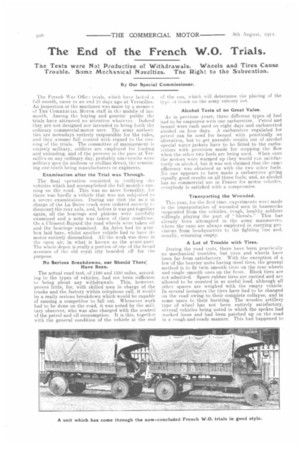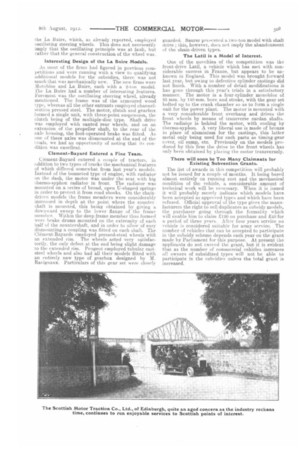The End of the French W.O. Trials.
Page 4

Page 5

If you've noticed an error in this article please click here to report it so we can fix it.
The Tests were Not Productive of Withdrawals. Wheels and Tires Cause Trouble. Same Mechanical Novelties. The Right to the Subvention.
The French War Offici trials, which have lasted a full month, came to an end 10 days ago at Versailles. An inspection of the machines was made by a memimr of THE COMMERCIAL MOTOR staff in the middle of last month. Among the buying and general public the trials have attracted no attention whatever. Indeed they are not designed nor intended to bring forth the ordinary commercial-motor user. The army authorities are nowadays entirely responsible for the rules, and they assume full control with regard to the running of the trials. The committee of management is entirely military, soldiers are employed for loading and unloading, and of the persons in t he pare at Versailles on any ordinary day, probably nine-tenths were military Ten (in uniform or civilian dress), the remaining one-tenth being manufacturers or engineers.
Examination after the Trial was Through.
The final operation consisted in verifying the vehicles which had accomplished the full month's running on the road. This was no mere formality, for there was hardly a vehicle that was not subjected 10 a severe examination. During our visit the nn n in charge of the La Buire track were ordered entirely dismount the rear axle, and, before it was put together again, all the bearings and pinions were carefully examined and a note was taken of their condition. On a Clement-Bayard the road wheels were taken off and the bearings examined. An Aries had its gearbox laid bare, whilst another vehicle had to have its motor entirely dissembled. All the work was done in the open air, in what is known as the avant-pare. The whole depot is really a portion of one of the broad avenues of the old royal city boarded off for the purpose.
No Serious Breakdowns, nor Should There: Have Been.
The actual road test, of 1180 and 1550 miles, according to the types of vehicles, had not been sufficient to bring about any withdrawals. This, however. proves little, for, with skilled men in charge of the trucks and the factory within telephone call, it would be a really serious breakdown which would be capable of causing a competitor to fall out. Whenever work had to be done on the road, it was noted by the military observer, who was also charged with the control of the petrol and oil consumption. It is this, together with the general condition of the vehicle at the end
of the run, which will determine the placing of the type of track on the army subsidy list.
Alcohol Tests of no Great Value.
As in previous years, three different types of fuel had to be employed with one carburetter. Petrol and benzol were each used on eight days and carburetted alcohol on four days. A carburetter regulated for petrol can be used for benzol with practically no alteration, but to get passable results out of alcohol special water-jackets have to be fitted to the carburetters with provision made for stopping the flow when the other two fuels are being used. When once the motors were warmed up they would run satisfactorily on alcohol, but it was not claimed that the same efficiency was obtained as with the two other fuels. No one appears to have made a carburetter giving equally good results on all three fuels, and, as alcohol has no commercial use in France for motor vehicles, everybody is satisfied with a compromise.
Transparting the Wounded.
This year, for the first time, experiments were made in the transportation of wounded men in hammocks suspended from the vehicles, tough, healthy soldiers willingly playing the part of " blesses." This has already been attempted in the army manceuvres, where the vans are always employed in carrying provisions from headquarters to the fighting line and, usually, returning empty.
A Lot of Trouble with Tires.
During the road tests, there have been practically no mechanical troubles, but tires and wheels have been far from satisfactory. With the exception of a few of the heavier units having steel tires, the general method is to fit twin smooth tires on the rear wheels and single smooth ones on the front. Block tires are not admitted. Spare rubber tires are carried and are allowed to be counted in as useful load, although all other spares are weighed with the empty vehicle. In several instances the tires have had to be changed on the road owing to their complete collapse, and in some cases to their bursting. The wooden artillery type of wheel has not been entirely satisfactory, several vehicles being noted in which the spokes had worked loose and had been patched up on the road in a rough-and-ready manner. This had 'happened to
the La Buire, which, as already reported, employed oscillating steering wheels. This does not necessarily imply that the oscillating principle was at fault, but rather that. the general construction of the wheel was.
Interesting Design of the La Buire Models.
As most of the firms had figured in previous competitions and were running with a view to qualifying additional models for the subsidies, there was not much that was mechanically new. The new firms were Motobloc and La Buire, each with a 2,-ton model. The La Buire had a number of interesting features. Foremost was the oscillating steering wheel, already mentioned. The frame was of the armoured wood typo, whereas all the other entrants employed channelsection pressed steel. The motor, clutch and gearbox formed a single unit, with three-point suspension, the clutch being of the multiple-disc type. Shaft drive was employed with canted rear wheels, and on an extension of the propeller shaft, to the rear of the axle housing, the foot-operated brake was fitted. As one of these axles was dismounted at the end of the rials, we had an opportunity of noting that its condition was excellent.
Clement-Bayard Entered a Fine Team.
Clement-Bayard entered a couple of tractors, in addition to two types of trucks the mechanical features of which differed somewhat from last year's models. Instead of the bonneted type of engine, with radiator on the dash, the motor was under the scat with big thernio-syphon radiator in front. The radiator was mounted on a series of broad, open U-shaped springs in order to protect it from road shocks. On the chaindriven models the frame members were considerably increased in depth at the point where the countershaft is mounted, this being obtained by giving a downward sweep to the lower flange of the frame member. Within the deep frame member thus formed were brake drums mounted on the extremity of each half of the countershaft, and in order to allow of easy dismounting a coupling was fitted on each shaft. The Clement-Bayards employed pressed-steel wheels with an extended rim. The wheels acted very satisfactorily. the only defect at the end being slight damage to the extended rim. Peugeot employed tubular caststeel wheels and also had all their models fitted with an entirely new type of gearbox designed by M. Ravignaux. Particulars of this gear set were closely
guarded. Saurer presented a two-ton model with shaft drive ; this, however, does not imply the abandonment of the chain-driven types, The Lath l is a Model of Interest.
One of the novelties of the competition was the front-drive Lath, a vehicle which has met with considerable success in France, but appears to be unknown in England. This model was brought forward last year, but owing to defective cylinder castings did not finish. With a number of detail modifications it has gone through this year's trials in a satisfactory manner. The motor is a four-cylinder monobloc of
mm. by 140 ram. bore and stroke, with the gear set bolted up to the crank chamber so as to form a single unit for the power plant. The motor is mounted with a very considerable front overhang and drives the front wheels by means of transverse cardan shafts. The radiator is behind the motor, with cooling by therm-syphon. A very liberal use is made of bronze in place of aluminium for the castings, this latter metal only being used for such parts as timing-gear cover, oil sump, etc. Previously on the models produced by this firm the drive to the front wheels has only been obtained by placing the motor transversely.
There will soon be Too Many Claimants for Existing Subvention Grants. _
The list of awards in this competition will probably not be issued for a couple of months. It being based almost entirely on running cost and the mechanical condition of the vehicle, a considerable amount of technical work will be necessary. When it is issued it will probably merely indicate which models have been accepted as approved types and which have been refused. Official approval of the type gives the manufacturers the right to sell duplicates as subsidy models, the purchaser going through the formality which will enable him to claim 120 on purchase and £40 for aperiod of three years. After four years service no vehicle is considered suitable for army service. The number of vehicles that can be accepted to participate in the subsidy scheme depends each year on the grant made by Parliament for this purpose. At present the applicants do not exceed the grant, but it is evident that as the number of commercial vehicles increases all owners of subsidized types will not be able to participate in the subsidies unless the total grant is increased.






















